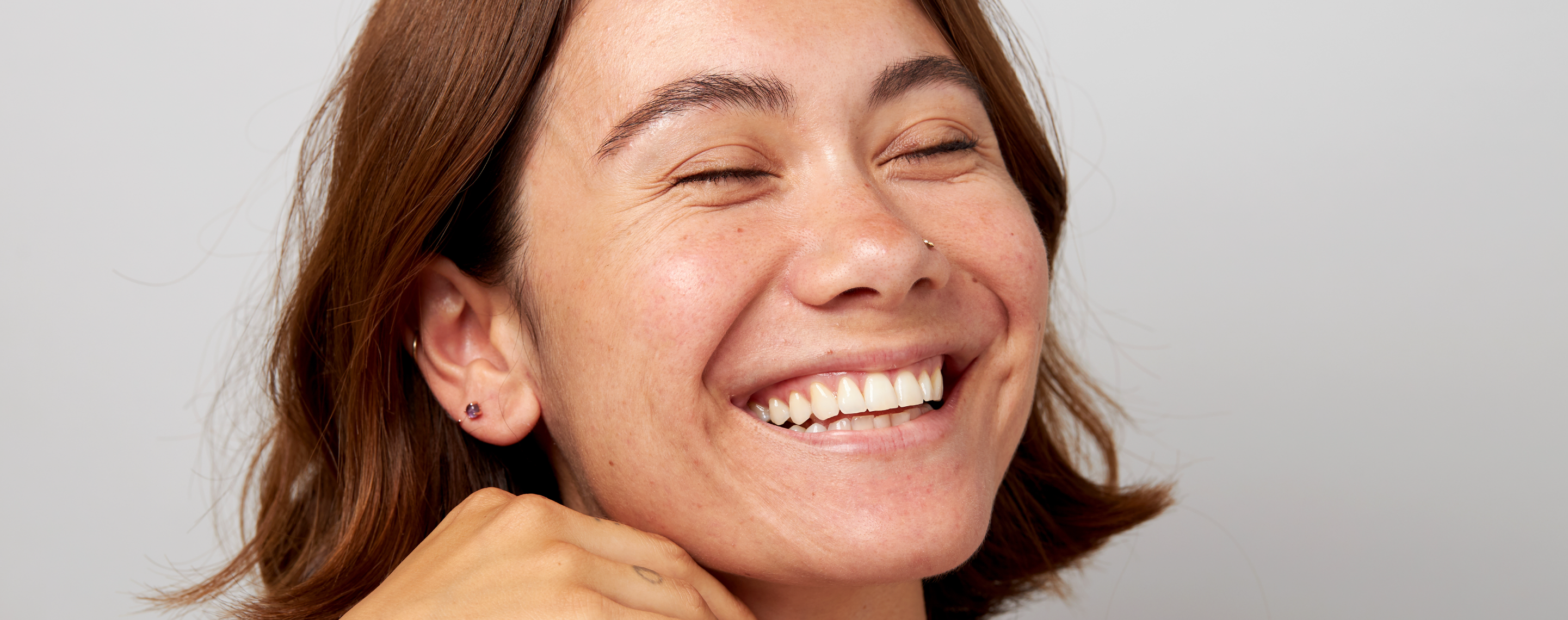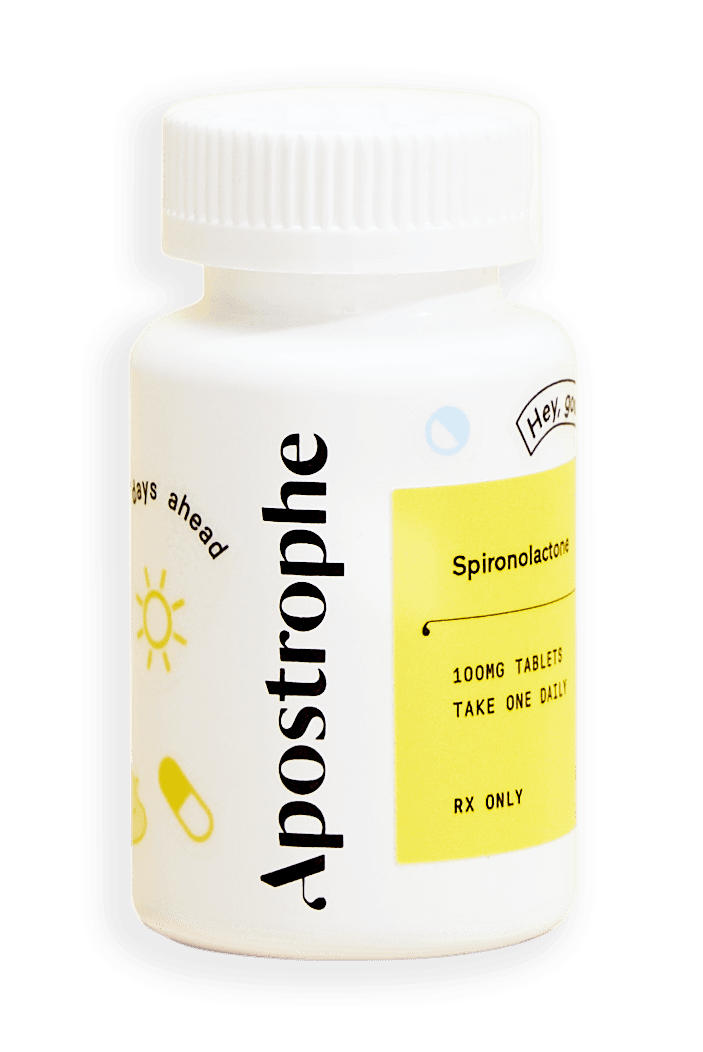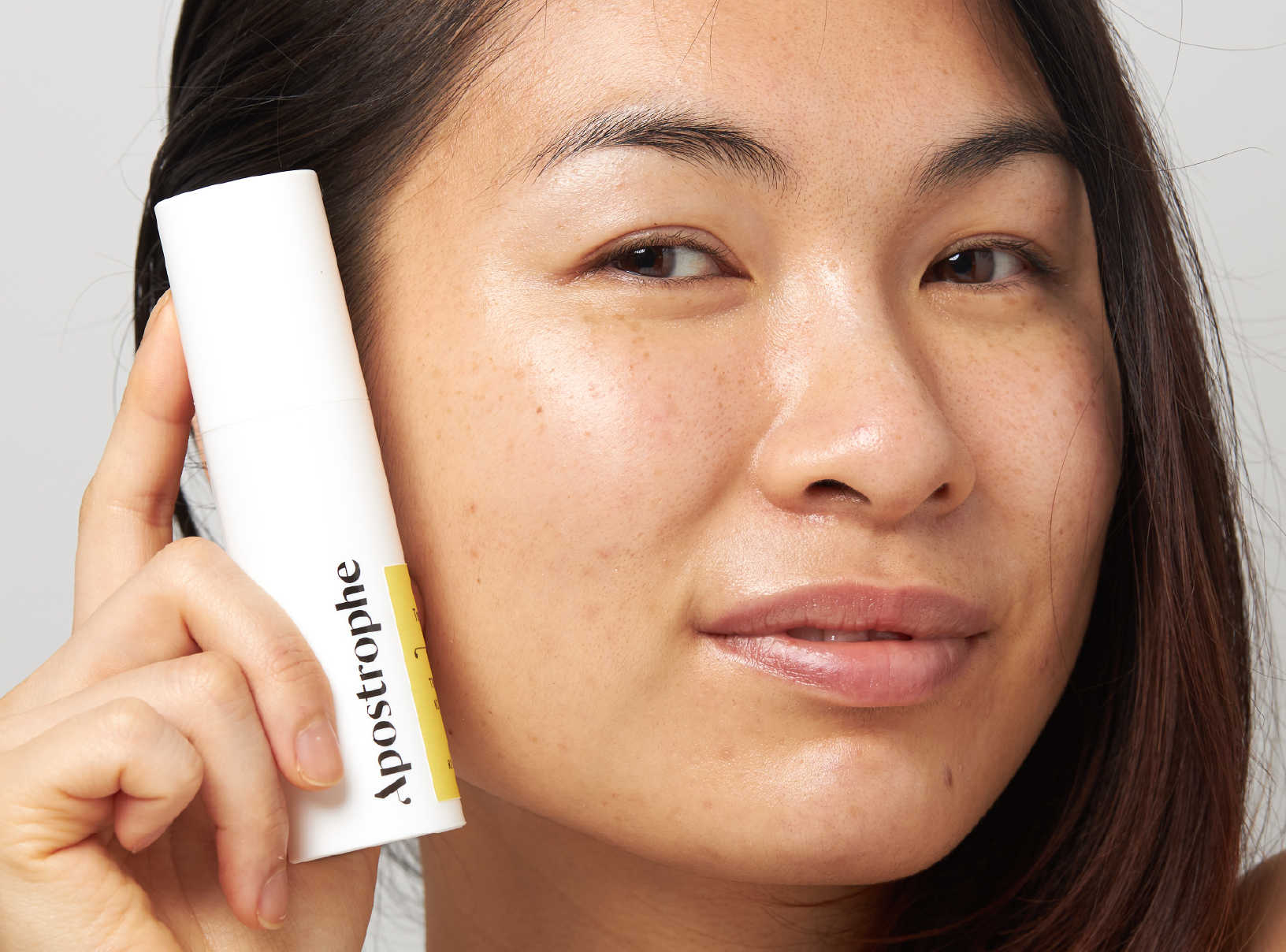Education
What Role Does Hormone Imbalance Play in Acne?


SHARE
Education
What Role Does Hormone Imbalance Play in Acne?
Medically reviewed by Aimee Paik, MD
Written by Apostrophe Team
Last updated 11/1/2024
What Role Does Hormone Imbalance Play in Acne?
Your teenage acne years may be long behind you. But for many adults, hormonal acne is still an everyday struggle. In fact, some adults develop acne without first experiencing it during puberty.
A common root of these later-life breakouts? Hormonal imbalances.
Even well past puberty, hormones can majorly affect your skin health. To clear up the issue, we’re going to break down the signs, causes, and treatments of hormonal acne.
What Does It Mean to Have Hormonal Acne?
From teenage breakouts to cyst clusters, all acne has its underlying triggers—one potentially being hormones.
Hormonal acne is a wide umbrella, covering a range of blemishes tied to our shifting hormones. Curious if your breakouts might fall under this category? It’s important to identify your acne’s root cause, since it can lead to smarter and more effective treatment. But before we define hormonal acne, let’s first clarify what “acne” means.
Acne: Direct Causes & Types
Acne begins in a pore in our skin, or the opening of a hair follicle. When a pore becomes clogged, it creates lesions on the skin, otherwise known as acne. Acne is caused by a combination of these direct culprits:
Abnormal keratinization - i.e. plugging of pores from abnormal shedding of skin cells.
Excess sebum (or oil) production that’s stimulated by a class of hormones called “androgens”
Inflammation
Proliferation of bacteria (specifically Cutibacterium acnes)
From tiny bumps to painful lesions, these breakouts fall into these two categories—non inflammatory (whiteheads, blackheads) and inflammatory (papules, pustules, nodules, cysts). Whether mild, moderate, or severe, all acne deserves attention. If you notice recurring acne breakouts, it’s best to tackle them with medical guidance.
Hormonal Acne: An Indirect Cause
Hormones aren’t considered a direct cause of acne. However, they can trigger or amplify acne conditions, boosting inflammation or sebum. The result? A higher likelihood for a clogged pore.
You might think hormonal fluctuations are just for teenagers. But in truth, all ages can experience hormonal shifts—and they can similarly result in acne. When these breakouts occur past the age of 25, it falls under the broader category of “adult acne.”
What Types of Hormonal Imbalances Cause Acne?
We know that one factor that causes acne is an increase in oil production, but what creates that excess sebum? It turns out, our hormones play a major part in the skin’s oil production—sometimes, a heavy-handed part.
Certain hormones are more likely to trigger acne than others. From cortisol to DHT, let’s review the typical culprits behind hormonal acne.
Androgens
Androgens are a group of male sex hormones found in all human bodies, with female bodies often producing less. While there are six androgens, elevated testosterone and DHEA typically underlie acne.
During puberty, androgens stimulate body developments, including increased sebum production. But for adults, androgen shifts are still very common. Beyond normal fluctuations (menstrual cycles, aging, etc.), certain factors can push androgens abnormally high, including:
Genetics
Environmental conditions
Medications
Certain rare disorders (congenital adrenal hyperplasia, tumors, etc.)
Particularly for women, high androgen levels could indicate an endocrine condition called polycystic ovary syndrome (PCOS). Alongside acne, PCOS creates an array of hormonal symptoms, like excess body hair and irregular periods.
If concerned that you might have PCOS, it’s best to contact a medical professional.
Cortisol
Known as the “stress hormone”, cortisol is a multi-purpose steroid produced in the body. It’s roles include metabolism regulation, memory formation, and, of course, stress responses.
While crucial at normal levels, too much cortisol creates a slew of negative health effects—including acne. Studies show that higher cortisol is correlated with excess acne.
How do you get high cortisol levels? A few ways, but the primary reason is stress. Physical, emotional, and mental stress can push cortisol levels high. So, if you’re concerned about hormonal acne, consider establishing a consistent bedtime and relaxation routine.
Estrogen & Progesterone
Typically, adult women experience acne more than adult men—for ages 20 to 49, about 37.4% of women compared to only 24.8% of men. So you might expect female sex hormones (estrogen and progesterone) to cause breakouts. However, there’s no substantial link between acne and these hormones—at least for now.
One reason for women’s higher acne rates might be natural hormone shifts during the menstrual cycle or menopause. When estrogen and progesterone fluctuate during these times, it may leave skin more vulnerable to acne-inducing hormones, like androgens.
What Are the Characteristics of Hormonal Acne?
When we say “hormonal acne,” we mean any acne that’s caused by hormonal shifts, from blackheads and whiteheads to cystic acne. So how can you tell the difference between typical acne and hormonal acne? There’s a few defining characteristics that separate hormonal acne from more typical acne.
If you suspect that you have hormonal acne, check for these factors:
Acne type – Hormonal acne can range in severity, including inflammatory and noninflammatory lesions. But for some, cystic acne can characterize hormonal breakouts. This kind of acne is characterized by large, painful lumps that are tender to the touch and inflamed.
Facial areas – Spots along the lower half of your face including your chin and jawline usually indicate hormonal causes. The sebaceous glands in these facial areas tend to be more sensitive to hormonal shifts.
Timing – For many women, menstrual cycles produce a few pimples like clockwork. The weeks before and during your period are common breakout times. Similarly, times of stress can trigger hormonal breakouts.
Traditional Treatments for Hormonal Acne
If you deal with it, you know—hormonal acne is chronic and frustrating.
Since the cause is physical, not external, finding a solution often takes more than a new face wash. Most hormonal acne sufferers have been through a ringer of creams, pills, and routines to varying success. Luckily, a few well-researched solutions have emerged over time.
Let’s review the oral and topical treatments typically used for hormonal acne.
Hormonal Medications
For hormonal acne, it’s common sense to nip the issue in the bud—via hormone-regulating medications.
Depending on your underlying imbalance, different medications can treat your hormonal acne. Here are some common options:
Oral contraceptives – For women, birth control (or oral contraceptives) can balance acne-prone hormonal shifts during menstrual cycles. Dermatologists usually recommend pills that contain both estrogen and progestin to control fluctuations.
Androgen blockers – While not originally intended for acne, spironolactone (a blood pressure medication) and flutamide (a prostate cancer medication) treat hormonal acne by blocking androgen receptors.
Isotretinoin – Commonly known as Accutane, isotretinoin isn’t exactly a hormonal medication. However, it’s a powerful oral retinoid that shrinks oil-producing glands and produces rapid cell turnover. While it can be used to treat hormonal acne, hormonally-induced acne will often recur once the effects of Accutane wear off after a year or two. Isotretinoin requires routine blood tests and often considerably dries skin, so consider the pros and cons.
Antibiotics
Sebum is just one acne culprit—skin bacteria can also inflame and worsen your hormonal acne.
As an initial treatment, dermatologists often recommend oral or topical antibiotics to calm moderate or severe acne. Antibiotics work by targeting the specific bacteria that causes acne, Cutibacterium acnes. They also have an anti-inflammatory effect which can reduce inflammation and help make big red marks fade more quickly.
It’s important to know that experts refer to Cutibacterium acnes as a “wimpy” bacteria because it’s easily eliminated using many topical treatments such as benzoyl peroxide.
Additionally, dermatologists treat antibiotics as a short-term solution only. Certain studies show that the longer you use antibiotics, the higher chance of developing side effects or microbial resistance.
Topical Treatments
For hormonal acne, most dermatologists combine oral medications with topical treatments to help keep acne under control for the long term. Experts recommend utilizing treatments with a tried-and-true skincare regimen:
Cleanse with a gentle face wash
Apply a topical treatment
Moisturize with a face lotion
Apply broad-spectrum SPF 30+ sunscreen
Acne-prone skin types should seek these research-backed ingredients for topical treatments:
Retinols or retinoids – As skin health powerhouses, retinols and retinoids help treat acne, fine lines, and hyperpigmentation. These vitamin A derivatives work by increasing cell turnover. At Apostrophe, we recommend prescription-strength varieties like tretinoin and tazarotene.
Benzoyl peroxide – This underrated but powerful acne treatment is a staple for acne-prone skin. Benzoyl peroxide can be used all over the skin and both reduces acne inflammation and can prevent antibiotic resistance within the skin's microbiome.
Azelaic acid – A newer addition to skincare markets, azelaic acid is a naturally derived compound for treating acne and rosacea. It also manages to target all four direct acne culprits—dead skin buildup, sebum, bacteria, and inflammation.
Spironolactone – This androgen-blocker comes in oral and topical form. Using topical spironolactone directly targets androgens at skin-level, making it safe for men and women to use. How long does it take for Spironolactone to work? Depending on your skin condition, you should expect to see progress between 8-12 weeks.
Salicylic acid – This acne-fighting substance is a common drugstore treatment, found in cleansers, toners, and spot treatments. While not as strong as other topicals, salicylic acid does reduce acne through its gentle exfoliation, clearing away clogging dead skin.
How to Treat Hormonal Acne Naturally
Sold as “cleaner” and “gentler,” natural treatments are popular skincare choices of today. However, unlike traditional treatments, their acne-battling powers are a little shaky.
From supplements to topicals, you might see these natural solutions targeted for acne treatment:
Tea tree oil
Witch hazel
Green tea
Apple cider vinegar
Evening primrose oil
While these substances might work for you, few studies prove their long-term treatment of hormonal acne. But more importantly, let’s redefine the word “natural.”
When skincare brands use the word “natural”, it’s more a marketing term than a description. Green tea and apple cider vinegar are natural—but so are chemicals found in common acne treatments. For example, salicylic acid is derived from willow tree bark, while retinoids are a form of vitamin A.
Additionally, natural doesn’t always mean effective. For instance, tea tree oil has antibacterial properties but isn’t nearly as proven or effective as topical treatments such as tretinoin or retinol. In the end, the “natural” label has little to do with effective treatment of hormonal acne.
Finding a Solution for Your Hormonal Acne
All acne is annoying at best, and debilitating at worst—especially long-term hormonal acne. But if you suspect hormonal imbalances are behind those chin cysts, don’t lose hope. With the right care, even the toughest hormonal acne can improve! Start an online dermatology visit with Apostrophe, and a dermatology provider will create a personalized skin care treatment plan for the clearer skin that you deserve.
Shop this post

Oral Spironolactone

Tretinoin

Finacea (azelaic acid)
Like what you just read? Sign up for our email list to get the scoop on skincare science delivered straight to your inbox.

Deep Dives
A dermatologist shares his thoughts on the recent studies about benzoyl peroxide and benzene.
Read More
Education
What is milia?
What is milia? Today, we’re jumping into one type of bump that you may have heard about most commonly in infants — milia.
Read More
Education
Best moisturizer for acne-prone skin
If you have combination acne-prone skin, figuring out which moisturizer is best for your skin might be tough. In this guide, we break down the best moisturizer for combination, acne-prone skin.
Read More
